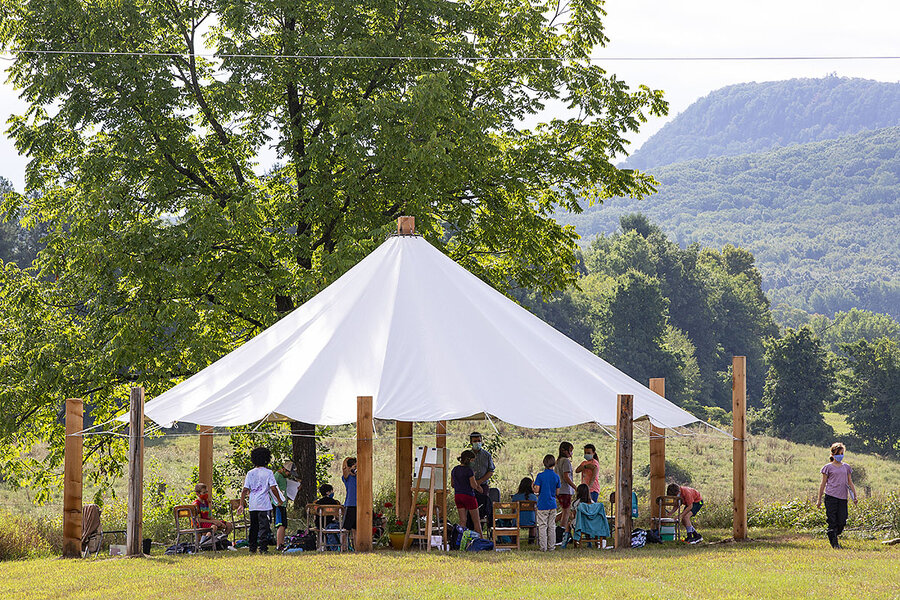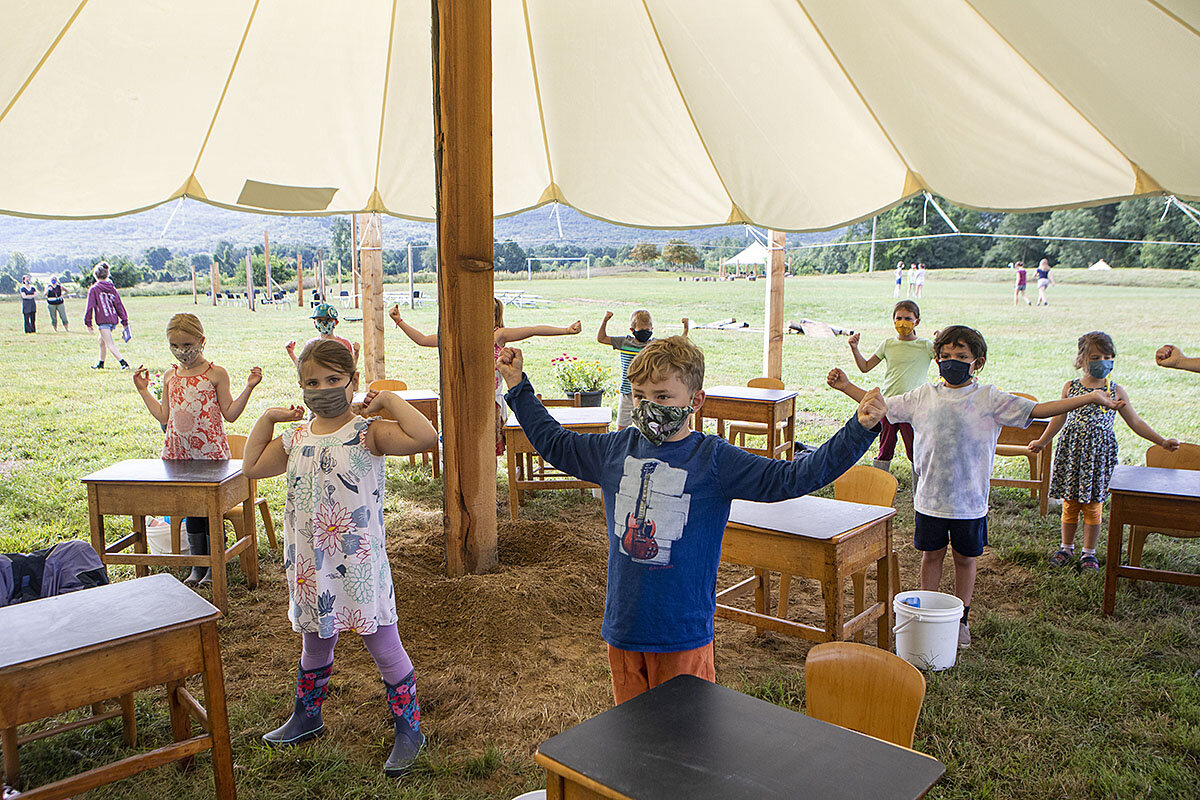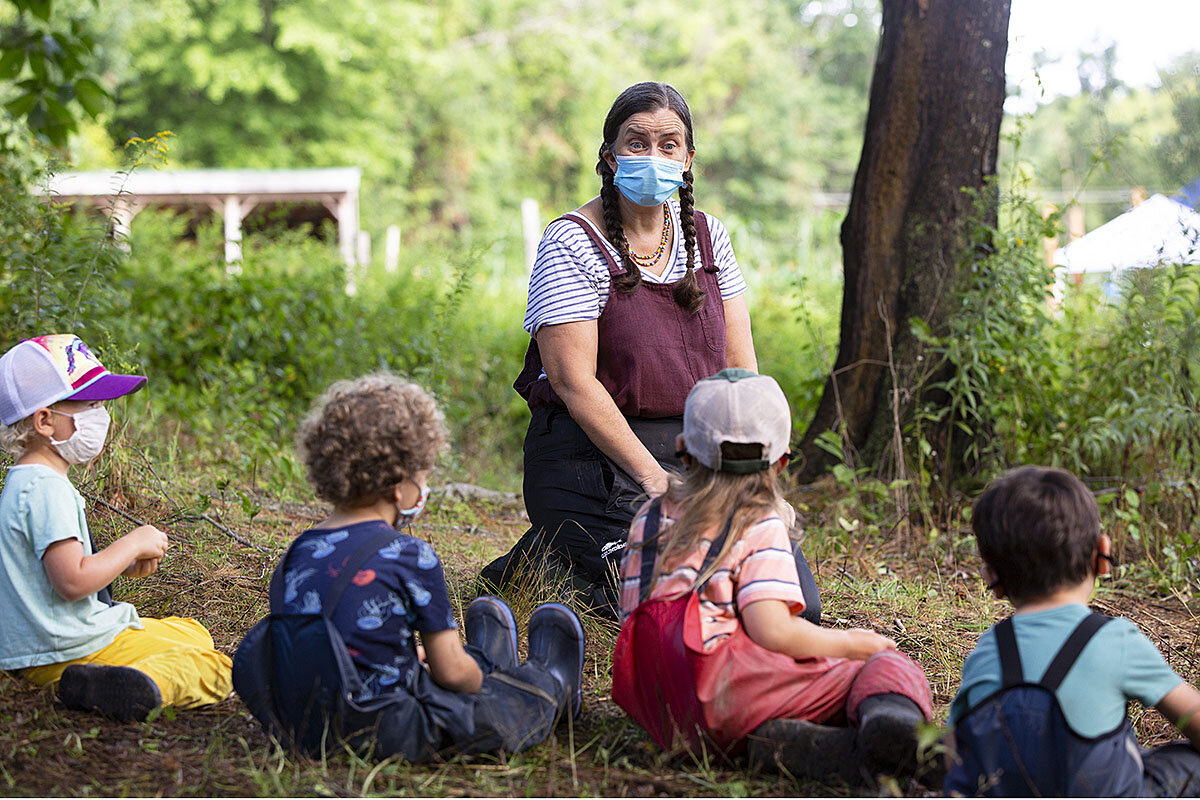Back to School: In-person, outside.
Loading...
At the Hartsbrook School, a private preK-12 Waldorf school in Hadley, Massachusetts, typical activities – talking, thinking, raising hands – are happening not in a traditional classroom but under waterproof canopies held up by repurposed cedar posts.
The outdoors is always part of daily life for the school’s 220 students, who regularly help care for livestock and gardens. But this year, Hartsbrook has added 16 outdoor classrooms, equipped with desks and blackboards.
The move outside is one of the solutions being used to bring kids back together during the pandemic – and it could become more than a stopgap. From coast to coast, educators in both private and public schools are finding creative ways to plan for learning outside, from open-air structures to makeshift classrooms in public parks or forested areas. Though tempered by logistics and funding, the benefits for students, some advocates say, go beyond preserving in-person education and accommodating social distancing.
Why We Wrote This
Solving problems during a pandemic often requires looking outward. As students in the U.S. return to learning, educators are finding ways to allow school to look like school – including teaching outdoors.
“We’re confident that being outside and being in the presence of nature will help begin to heal some of the trauma [from the pandemic],” says Sharon Danks, CEO and founder of the nonprofit Green Schoolyards America, based in Berkeley, California.
Interest is coming from both rural and urban communities looking to reopen safely. Green Schoolyards America has teamed up with three other organizations to launch the National COVID-19 Outdoor Learning Initiative to help. Ten working groups are creating an online how-to manual for schools, says Ms. Danks, who expects some schools will continue on outdoors after the pandemic.
For many schools, education outdoors offers a way to resume at least some level of in-person learning, a key element from an equity standpoint. The spring’s rapid transition to remote learning meant students with little to no internet access and no computer were at a major disadvantage. Disparity issues continue. But experts note converting existing outdoor space doesn’t always require a lot of resources, making it an option available to a variety of schools.
The idea has caught on in New York City, where students can start learning in-person as of Sept. 21. Parents are among those who have been pushing for outdoor options for their students in the country’s largest school district. In late August, Mayor Bill de Blasio announced principals could submit outdoor learning plans that would use either their own grounds or request space in city parks or streets. So far, several hundred have been approved, with the city working on the logistics of such plans, which might affect parking among other things.
Trish Appel Peterson, the principal of PS8, The Robert Fulton School, which teaches about 650 K-5 students in the Brooklyn Heights neighborhood, worked with her colleagues to submit a plan, still pending approval, that proposes closing two nearby streets, using tents on each for classrooms. The school would also use outdoor space on school grounds.
Ms. Peterson sees the potential for creativity to flourish in an outside class, when there is less technology and more talking. “I think it’s going to be interesting to see how things change when we’re outside and there isn’t a screen as a back up,” she says.
Lea Ciavarra, co-founding partner at Lubrano Ciavarra Architects in Brooklyn, helped PS8 build a plan for safe indoor and outdoor learning. Ms. Ciavarra, whose daughter is heading into second grade at the school, says outdoor options are definitely viable, just as they were during epidemics early in the 20th century.
“You get outside, there’s fresh air and you get reinvigorated,” she says. “Why wouldn’t you weave more of that into the day for a child?”
Further north, outdoor classrooms are also a priority at Hartland (Vermont) Elementary School, a public K-8 school with some 270 students. The community has raised more than $8,000 and counting to create these spaces. Ahead of the Sept. 8 reopening, which will include both in person and remote learning, Hartland raised the number of classrooms it has on adjacent, town-owned forest from two to five. On school grounds, carports have been set up to allow for teaching underneath them.
Hartland teachers will have the option to have class outside, inside, or a combination, Principal Christine Bourne says. “Hopefully it’ll be so successful that once things get back to normal, we’ll continue to use [the outdoor classrooms] and we can adapt our curriculum to have more outdoor learning,” she says. “We’re looking at this as an opportunity.”
Hartland’s kindergarten has used an outdoor classroom on the nearby 17-Acre Wood one day per week. Lauren Skilling, a kindergarten teacher, recommends educators set aside time for students learning outside to explore on their own and build their problem-solving skills.
Parent Jay Nash, a musician who helped with the fundraising effort for Hartland, recalls the positive impact from his daughter being in the kindergarten program. “When kids get outside ... I think that they become the best possible versions of themselves,” he says. “I have observed kids to be more calm, more considerate, and more likely to assimilate and retain new information while they are outdoors.”
Rachel Kennedy has seen that happen many times. She founded the Forest Kindergarten program at Hartsbrook, the Waldorf school in Massachusetts, where children learn about levers by using boards and tree stumps to make a seesaw or a balance board. She says such activities develop the physical and mental skills that drive creativity – and without leaning on technology.
“It builds such confidence and such agency, and those are other pieces I feel modern children really need,” Ms. Kennedy says, adding that those qualities help older kids, too.
Some outdoor settings are more conducive to learning than others, with urban educators, for example, competing with ambient city noise like construction. And any outdoor environment is prone to another variable: weather. That makes outdoor learning something that will be limited to certain times of the year in some states. Hartsbrook plans to offer outdoor heat sources as it gets colder, for example, and some schools may follow the lead of previous eras with outdoor learning in the United States, in which students bundled up in the winter.
Even with the hurdles, administrators around the U.S. are keeping learning outside as an option. One of the districts working with Green Schoolyards America is the Boulder Valley School District (BVSD) in Colorado, which includes 56 schools with a total of about 29,000 students. The school year began on Aug. 26 with district-wide remote learning, but planning for the outdoor option is well underway, says Ghita Carroll, the district’s sustainability coordinator. And it’s nothing new for this district.
“What’s new is using it in a more universal way where we can even teach math outside,” Ms. Carroll says.
BVSD’s outdoor classrooms would come into play as part of a hybrid learning model, of both in-person and remote learning, when that option is deemed safe by local authorities. At each potential outdoor learning site, the district has considered various factors, including shading, space, and the location of grassy areas. Ms. Carroll says outdoor classrooms free up space for in-person learning indoors, and they provide a valuable way for students and teachers to connect. “A little bit can go a long way,” she says.
The Salt Lake City School District, a public district with about 24,000 students, is also starting remote, but is including outdoor classroom spaces in a hybrid learning model to be used when in-person learning is an option again. Shea Wickelson, a teacher at the district’s Salt Lake Center for Science Education, a lab school teaching grades 7-12 on two campuses, headed up the district’s outdoor learning plans ahead of the Sept. 8 start.
“We’re not re-creating the indoor classroom,” Ms. Wickelson says. “Our idea right now is just to be able to identify places we can use outside at the drop of a hat without big infrastructure changes and without a lot of money.”
Ms. Kennedy, the teacher from Hartsbrook, expects a lasting, positive impact from more children problem-solving together in the outdoors. “That’s a real pull toward compassion and figuring out how to help each other,” she says. “And I think that’s more needed than ever.”







